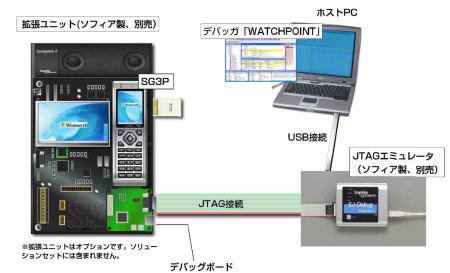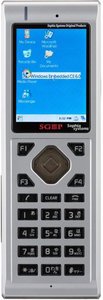IP phone design runs Linux
Sep 21, 2007 — by LinuxDevices Staff — from the LinuxDevices Archive — 13 views A large embedded consulting house in Japan has started shipping a hardware reference design for handheld IP (Internet protocol) phones. Based on a Marvell PXA310 (“Monahans-LV”) processor clocked at 624MHz, Sophia Systems's Sandgate 3-P design runs Linux, including Trolltech's Qtopia Phone Edition, or Windows CE/Mobile 6.
A large embedded consulting house in Japan has started shipping a hardware reference design for handheld IP (Internet protocol) phones. Based on a Marvell PXA310 (“Monahans-LV”) processor clocked at 624MHz, Sophia Systems's Sandgate 3-P design runs Linux, including Trolltech's Qtopia Phone Edition, or Windows CE/Mobile 6.
Sophia employs about 200, and calls itself “one of the world's most substantial embedded solution providers.” It claims to designed devices marketed under some of the biggest brands in the electronics industry.
Sophia says it supplies its hardware reference designs with not only a BSP (board support package), but also with tools and optional third-party offerings, such as OS porting services, middleware, and drivers/driver development. It claims this approach makes its designs “much closer to a final product.”

Sophia Sandgate 3-P design
(Click to enlarge)
Potential applications for the Sandgate 3-P design listed by Sophia include:
- Developing or evaluating handheld terminals or IP phones
- Development and evaluation of applications software and middleware
- Research and development of user interface technology
- Field verification of mobile phones & handheld terminals
- Systems development & verification
- Practical evaluation and demonstrators for handheld terminals aimed at enterprise applications
 Sandgate 3-P (Click to enlarge) |
The design is based on Marvell's 624MHz PXA310 (Monahans-LV) system-on-chip. This follow-up to the PXA300 (Monahans-L) adds on-chip VGA video acceleration.
Marvell typically delivers the PXA310 with NAND flash and DDR RAM in a module stack. The Sandgate 3-P design includes 128MB of RAM and 256MB of flash, expandable via a MicroSD slot.
The design includes a 2.2-inch QVGA (640×480) color LCD with 65k colors. It also appears to integrate a 1.3-megapixel digital camera.
The design also integrates at least three interesting radio connectivity interfaces. It supports 802.11b/g WiFi, Bluetooth, and “W-SIM” cards.
W-SIMs have the same fingernail-sized form-factor as the SIMs (subscriber identity modules) used in GSM/GPRS phones. However, they integrate an entire radio baseband subsystem, including antenna. The idea is to enable designers to inexpensively add cellular radio capabilities to all kinds of low-cost consumer electronics devices — apparently including IP phones. Currently, W-SIMS appear to be available only for Japan's somewhat dated “Personal Handyphone” network, however.
Possibly referring to the Sandgate 3-P platform's support for W-SIMs, Sophia said, “In cooperation with telecommunication software vendors engaged in state-of-the-art development, the introduction of the new platform has achieved a fusion of embedded and middleware technologies, making it easier for embedded development engineers to add telecommunication functions to their final product offerings.”
Additional 3-P I/O includes a mini-AB USB port and IrDA. The design measures 5.7 x 1.9 x 0.9 inches (145 x 48 x 22mm), and weighs 3.9 ounces (110 grams). It uses a 3.7-Volt, 1300mAh battery.
On the software side, the 3-P design is “optimized for handheld OS standards,” Sophia says, citing Linux/Qtopia Phone Edition, as well as Microsoft Windows CE 6.0 and Windows Mobile 6. Qtopia, in particular, has proven popular in VoIP phones, creator Trolltech says, with about 40 design wins as of six months ago.
Sophia says its Sandgate 3-P design will enable manufacturers to simultaneously develop hardware and software. The company offers a USB bus-powered “EJ-Debug” JTAG emulator and Watchpoint debugger software. The combo is said to support “source level debugging, branch trace reconstruction, and access to specific functions of the PXA built-in register sets.” Other features include direct downloads to flash memory, and support for “various OS development environments,” specifically including Microsoft Visual Studio and the Windows CE Platform Builder tool.
The Sandgate 3-P design, USB JTAG emulator, and Watchpoint debugger appear to be available now. Pricing was not disclosed.
This article was originally published on LinuxDevices.com and has been donated to the open source community by QuinStreet Inc. Please visit LinuxToday.com for up-to-date news and articles about Linux and open source.